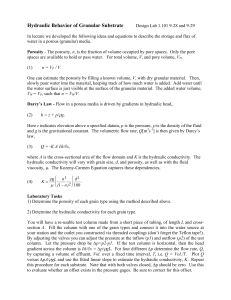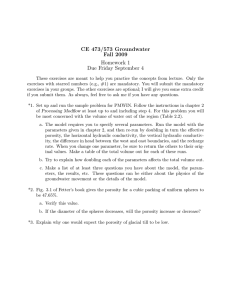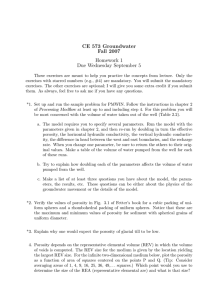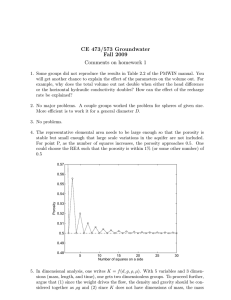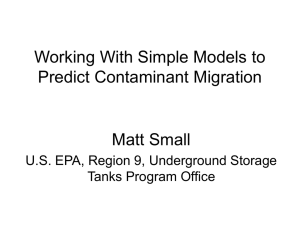Water Resources - Experiment #2B 1.101 Sophomore Design - Fall 2006
advertisement
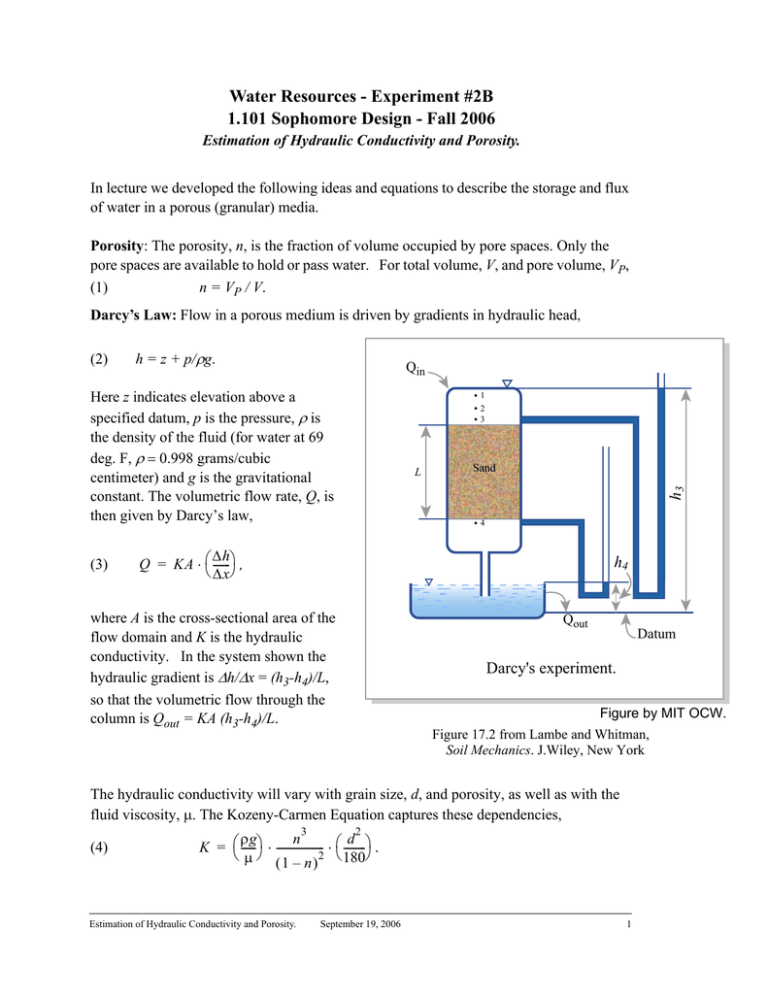
Water Resources - Experiment #2B 1.101 Sophomore Design - Fall 2006 Estimation of Hydraulic Conductivity and Porosity. In lecture we developed the following ideas and equations to describe the storage and flux of water in a porous (granular) media. Porosity: The porosity, n, is the fraction of volume occupied by pore spaces. Only the pore spaces are available to hold or pass water. For total volume, V, and pore volume, VP, (1) n = VP / V. Darcy’s Law: Flow in a porous medium is driven by gradients in hydraulic head, (2) h = z + p/ρg. Qin Here z indicates elevation above a specified datum, p is the pressure, ρ is the density of the fluid (for water at 69 deg. F, ρ = 0.998 grams/cubic centimeter) and g is the gravitational constant. The volumetric flow rate, Q, is then given by Darcy’s law, (3) 1 2 3 Sand h3 L 4 ∆h Q = KA ⋅ ⎛ -------⎞ , ⎝ ∆x⎠ h4 Qout where A is the cross-sectional area of the flow domain and K is the hydraulic conductivity. In the system shown the hydraulic gradient is ∆h/∆x = (h3-h4)/L, so that the volumetric flow through the column is Qout = KA (h3-h4)/L. Datum Darcy's experiment. Figure by MIT OCW. Figure 17.2 from Lambe and Whitman, Soil Mechanics. J.Wiley, New York The hydraulic conductivity will vary with grain size, d, and porosity, as well as with the fluid viscosity, µ. The Kozeny-Carmen Equation captures these dependencies, 3 (4) 2 ρg n d K = ⎛ ------⎞ ⋅ ------------------2- ⋅ ⎛ ---------⎞ . ⎝ µ⎠ ⎝ 180⎠ (1 – n) Estimation of Hydraulic Conductivity and Porosity. September 19, 2006 1 Laboratory Tasks: Determine the Porosity and Hydraulic Conductivity for each Material Repeat the following procedure for each of the three test materials, and report the porosity and hydraulic conductivity, with uncertainty, for each material. You will have a re-usable test column made from a short piece of tubing, with crosssection A. Fill the column with one of the grain types and set it vertically in the ring-stand provided, as shown in the figure below. Place a mesh at the top of the column. To record the length of sediment, L, remember that some of the sediment column is hidden behind the end cap. mesh to protect sediment surface from erosion rubber band 2 L L1 rubber band 1 Porosity: The first task is to fill the column with water and eliminate trapped air. To do this you must fill the column from the bottom, by connecting the hose and funnel as shown above. Before you begin filling, mark two positions on the column with rubber bands at approximately 1/3 L and 2/3 L, as shown above. When you begin filling water through the funnel, watch the wetted front climb up the column. Stop when the front reaches rubber band 1. As you continue to add water, carefully note the volume of water added, Vw, to raise the wetted front to band 2. The volume of water added between rubber bands 1 and 2 fills the pores in this region, i.e. VP=Vw. The total volume of this region is V = AL1. Now you can calculate the porosity of this material using equation (1). Estimation of Hydraulic Conductivity and Porosity. September 19, 2006 2 Hydraulic Conductivity: Move the rubber bands to a position about 4 inches above the top of the sediment. This position is the target for the water level. Continue filling the column from below until water reaches the rubber bands. Then, close the valve at the base of column. Using a bucket to catch the water, carefully remove the funnel and hose from the base of the column. Place a beaker beneath the column. Now chose the group member with the greatest eye-hand coordination to be the water level monitor (WLM). This person will be responsible to maintain the water level at the rubber band marking through out the experiment. She/he should fill a large beaker with water and stand ready to pour it into the top of the tube. Now, open the valve at the base. At the same time, WLM should begin filling water from top, filling at just the right rate to maintain the water surface at the rubber band. Once this is perfected, you can determine the flow rate Q by capturing a measured volume of effluent, Vol., over a fixed time interval, T, i.e. Q = Vol./T. Repeat the measurement to find four estimates of Q. Use the four estimates to determine a mean and standard deviation. The standard deviation represents the uncertainty in the measured quantity Q. Finally, use equation 3 to estimate the hydraulic conductivity. Compare the order of magnitude of your result to the KozenyCarmen Equation (4). rubber band ΛL22 gL2 z = L, pp==ρ ργΛ 2 L datum z = 0, p = 0 beaker to catch water beaker to catch water At the end of this lab, hand in a summary sheet that includes the following: 1) Name of each team member 2) Table presenting the hydraulic conductivity, K, with uncertainty for each material tested. Estimation of Hydraulic Conductivity and Porosity. September 19, 2006 3
